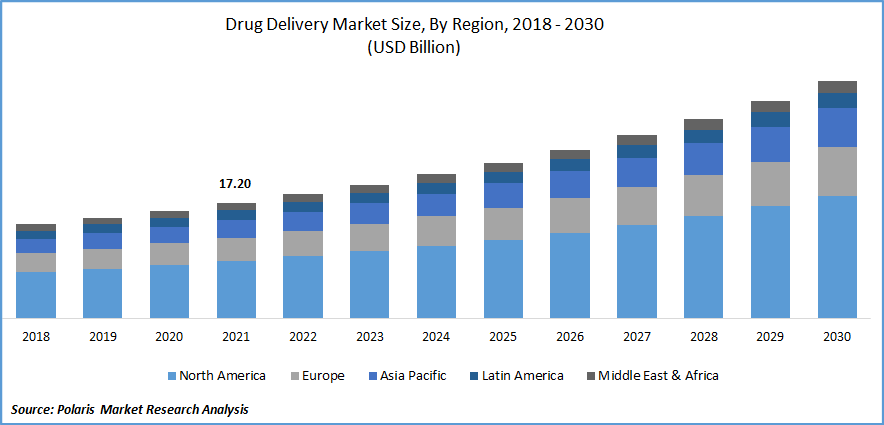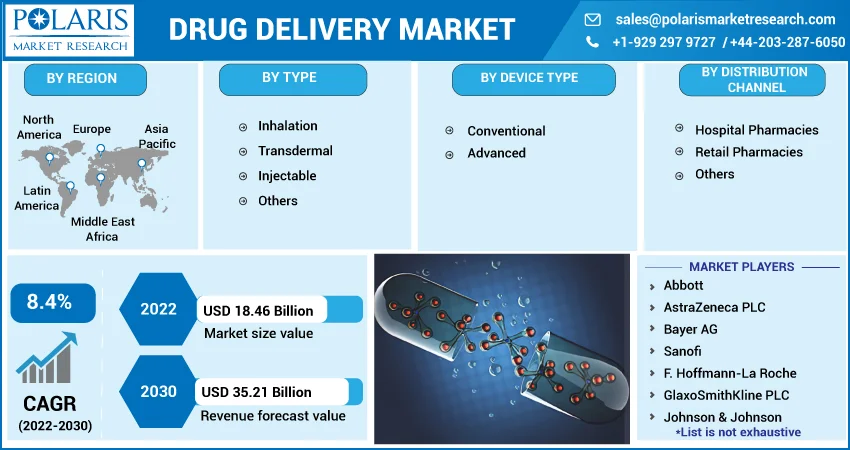
Drug Delivery Market Share, Size, Trends, Industry Analysis Report, By Type; By Device Type (Conventional, Advanced); By Distribution Channel; By Region; Segment Forecast, 2022 - 2030
- Published Date:Dec-2022
- Pages: 118
- Format: PDF
- Report ID: PM1328
- Base Year: 2021
- Historical Data: 2018-2020
Report Outlook
The global drug delivery market was valued at USD 17.20 billion in 2021 and is expected to grow at a CAGR of 8.4% during the forecast period.
The increasing burden of chronic diseases like diabetes, cardiovascular disease, renal disease, asthma, cancer, and others is a major factor driving the market growth. As a result, there is an increasing need for a controlled drug delivery system.
Product innovations, technological advancements, and the introduction of regulatory policies have been detailed in the report to enable businesses to make more informed decisions. Furthermore, the impact of the COVID-19 pandemic on the Drug Delivery Market demand has been examined in the study. The report is a must-read for anyone looking to develop effective strategies and stay ahead of the curve.

Know more about this report: Request for sample pages
Furthermore, as more people become aware of these illnesses, there is projected to be an increase in the demand for novel medicines that are cutting-edge and effective, which will motivate companies to develop new drug delivery methods. For instance, Song et al. revealed in a recent systematic study from the Lancet, in 2020, over 28% of people in the general population aged 30-79 years had an abnormal Carotid intima-media thickness (CIMT) of 1.0 mm and higher, indicating that this effect affects well over one billion people. Based on the findings, cardiovascular diseases are a primary global health concern.
In addition, according to the American Heart Association, 101.5 million stroke cases worldwide in 2019. Ischemic stroke cases were 77.2 million, intracerebral hemorrhage cases were 20.7 million, and subarachnoid hemorrhage cases were 8.4 million. Similarly, the American Cancer Society (ACS) forecasted a significant increase in cancer cases & fatalities in 2022. There are expected to be around 1.9 Mn new cancer cases & 609,360 cancer-related deaths in the U.S.
Thus, with the latest investments and developments in the field, the high and rising burden of chronic diseases is anticipated to pave the way for developing novel drug delivery systems. The studied market is thus expected to expand throughout the forecast period.
The COVID-19 pandemic's emergence hugely affected the market for innovative drug delivery systems since it stimulated enormous investment in the study of COVID-19 vaccine development and other potent treatments. For instance, numerous studies have discussed various revolutionary distribution systems, and successful results from this research may favor the industry under study.
For instance, in a research study entitled "Nanomaterial based drug-delivery platforms as the promising carriers for the patients suffering with COVID-19," published in August 2021, processing methods for nanomaterials, unique benefits over conventional drug delivery methods, and their toxicity through risk analysis were all examined. This review offers insights into using such systems to treat COVID-19 to improve bioavailability, lessen toxicity, and improve the efficacy of current medications. As a result, it is anticipated that COVID-19 will have a long-term effect on the market for innovative drug delivery systems.

Know more about this report: Request for sample pages
Industry Dynamics
Growth Drivers
Oral channels attracted the most interest among different delivery methods because of their unique features, including continuous and controllable distribution, convenience of administration, viability of the solid formulations, patient compliance, and cost-effectiveness. Both doctors and patients like to use them since they are the most reliable techniques for delivering medications with successful local and systemic effects.
Additionally, patients are more aware of cutting-edge products now that medical equipment is becoming more computerized. The digitalization system offers a number of benefits, including regulated dosage, higher self-administration flexibility, and needle-free injection, which has increased device acceptance. For instance, EfficioTM, a cloud-based data management platform, will be compatible with the SynchroMed II intrathecal medicine delivery system when it was released in 2020. This tool will help doctors manage their targeted medicine delivery pump practices more effectively when caring for patients with severe spasticity, cancer pain, and chronic pain.
Report Segmentation
The market is primarily segmented based on type, device type, distribution channel, and region.
|
By Type |
By Device Type |
By Distribution Channel |
By Region |
|
|
|
|
Know more about this report: Request for sample pages
Injectable segment is the industry's largest market segment.
The injectable market is anticipated to grow at a significant CAGR during the forecast period. Due to the system's capacity to deliver medications to the target site, which enables it to be more localized, the injectable sector is predicted to have a major share of the drug delivery market share.
Furthermore, the category's expansion will be boosted by patients' greater preference for ready-to-use devices versus vial-and-syringe goods. However, whether market-driven or technological-driven, the goal is to increase therapeutic efficacy and patient quality of life. For instance, in October, 2022, it reported that it had finished constructing a new research facility devoted to formulating injectable pharmaceuticals, concentrating on small molecules. Eisai has increased its focus on drug development goals to include antibodies, antibody-drug conjugates, and nucleic acid therapeutics.
Conventional segment will account for a higher share of the market.
In 2021, the conventional segment held the most significant market share. This market has the largest share since devices are inexpensive, and there is a growing market for biosimilar products. Furthermore, it is predicted that the frequency of chronic illnesses like diabetes, asthma, and cardiovascular diseases will increase demand for traditional systems, particularly in poor countries that rely more on conventional systems than current systems.
For instance, the WHO estimates that 65 million people worldwide suffer from moderate to severe COPD. In 2022, there will be an estimated 300 million asthma sufferers worldwide, and up to 10% of adults over 40 may develop COPD, with millions perhaps going untreated. In the United States, Europe, and Japan, there will be 54.9 million cases of asthma by 2036, up from 51.3 million in 2016. This is expected to hasten the adoption of conventional device types during the anticipated time.
Hospital Pharmacies is expected to hold the significant revenue share
Hospital pharmacies are expected to dominate the market over the forecast period due to hospitals' significant patient foot traffic. Hospital pharmacies are a crucial component of the infrastructure. Therefore, the number of people receiving medication from hospital pharmacies is anticipated to increase as more patients visit hospitals. The rising distribution of these systems from hospital pharmacies, projected to occur in many different countries as hospitals become more popular, will contribute to the segmental expansion.
Shortly, it is probable that the global market for hospital pharmaceuticals would benefit from the sharp increase in the prevalence of numerous chronic diseases like diabetes, cancer, and a wide range of cardiovascular ailments. Additionally, rising healthcare costs in emerging nations are projected to increase the need for hospital medications.
The demand in North America is expected to witness significant growth
The primary reasons for this domination include beneficial health reimbursement, an increasing emphasis on geriatric care, and an increase in patient adoption of drug administration. One major cause was the US government's rapid growth of the COVID-19 immunization campaign, which raised demand for syringes. For instance, the Path modeling 2021 study projects a surge in syringe demand for the COVID-19 vaccination, which is expected to reach more than 4 billion from the end of 2021 to the middle of 2022.
Furthermore, Asia Pacific is expected to witness a high CAGR in the market as a result of factors such as an increase in the number of research projects focusing on novel therapies, a rise in the funding allocated to discovering novel drugs, and rising public awareness of novel drug delivery methods. The prevalence of chronic illnesses and disorders is rising here.
Competitive Insight
Some major global players operating in the global market include Abbott, AstraZeneca, Bayer, Sanofi, La Roche, GlaxoSmithKline, Johnson & Johnson, Merck, Novartis, Pfizer, Antares Pharma, and Accord Healthcare.
Recent Developments
- In October 2022, Kindeva Treatment Delivery partnered with Temple University to provide liquid intradermal transdermal systems to evaluate nanoparticle-based techniques to counteract tumor treatment resistance in the mice models.
Drug Delivery Market Report Scope
|
Report Attributes |
Details |
|
Market size value in 2022 |
USD 18.46 billion |
|
Revenue forecast in 2030 |
USD 35.21 billion |
|
CAGR |
8.4% from 2022 - 2030 |
|
Base year |
2021 |
|
Historical data |
2018 - 2020 |
|
Forecast period |
2022 - 2030 |
|
Quantitative units |
Revenue in USD billion and CAGR from 2022 to 2030 |
|
Segments covered |
By Type, By Device Type, By Distribution Channel, By Region |
|
Regional scope |
North America, Europe, Asia Pacific, Latin America; Middle East & Africa |
|
Key companies |
Abbott, AstraZeneca PLC, Bayer AG, Sanofi, F. Hoffmann-La Roche, GlaxoSmithKline PLC, Johnson & Johnson, Merck, Novartis AG, Pfizer, Antares Pharma, Accord Healthcare, and GSK. |
We strive to offer our clients the finest in market research with the most reliable and accurate research findings. We use industry-standard methodologies to offer a comprehensive and authentic analysis of the Drug Delivery Market. Besides, we have stringent data-quality checks in place to enable data-driven decision-making for you.
Browse Our Top Selling Reports:
Medical Tubing Market Size, Share 2024 Report
Health Sensors Market Size, Share 2024 Report
Infectious Disease In-vitro Diagnostics Market Size, Share 2024 Report

